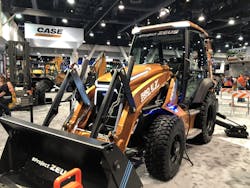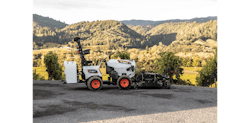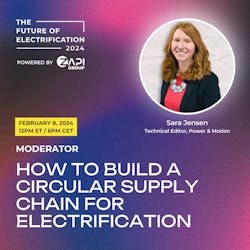Technological Developments are Aiding Electrification of Heavy Vehicles and Equipment
The electrification of heavy-duty trucks and mobile equipment continues to grow. With that comes ongoing technological developments in the fluid power sector as well as increasing use of electric alternatives, benefiting the electric motion control segment.
As the recent CES show demonstrated, technology advancements are ongoing to help improve electrification solutions as well as increase their market adoption. Several OEMs and component suppliers were on hand at the event to demonstrate their latest products.
Doosan Bobcat, for instance, made another big debut at CES 2024 with the unveiling of its autonomous and electric articulating tractor the AT450X. It allows for either autonomous or remote operation for tasks such as mowing, spraying and material transport through the use of artificial intelligence (AI) which helps the machine learn how to maneuver safely through its working environment.
This is yet another in a growing line of electric machines for the company. At CES 2022, the company unveiled what is considered the world's first all-electric compact track loader the T7X, which it developed in collaboration with Moog Construction. During the 2024 event, Bobcat also exhibited its S7X all-electric skid steer loader which it also collaborated on with Moog and originally debuted at CONEXPO-CON/AGG 2023.
Both machines feature full-electric systems which means no hydraulics are used for various work functions; instead, Moog electric actuators and other electronic drive components are used to power the vehicle and its various work functions. Electric actuator technology has evolved to a point where it is becoming feasible to use it in heavier machine applications like the ones developed by Bobcat. Though not able to replace hydraulics in all applications, electric actuators' capabilities are increasing and are expected to continue doing so in the coming years.
Read more about the Bobcat machines and other news from CES 2024.
Advancements in Component and System Designs Key to Ongoing Electrification Success
Developing the proper technology for electric vehicles and machines is integral to ensuring not only their performance but also their ability to achieve the desired goals of electrification — more efficient and emissions-free operation.
Because of this, there have been many developments taking place aimed at improving component and system designs as well as creating newer technology options.
Want more on electric vehicles?
If you'd like to learn more about what's going on in the world of electric vehicles, be sure to follow Endeavor Plugged-In on LinkedIn.
This page is dedicated to all things electric vehicles and curated by editors from the various publications at Endeavor Business Media covering electrification, including Power & Motion. From energy, utilities, infrastructure, commercial vehicles, vehicle repair, manufacturing, design and more, there are a range of topics related to electric vehicles of all types being covered.
Follow our new page for news and articles related to electric vehicles as well as our soon-to-launch monthly video series during which editors from Endeavor Business Media will come together to discuss various topics related to electric vehicles such as new technology developments, safety needs, challenges associated with electrification and more.
Batteries and electric motors are important components enabling electrification. And while not new technologies, there continue to be advancements made with these technologies to help further improve their performance as well as sustainability, efficiency and more.
Most recently, a team of researchers at the Pacific Northwest National Laboratory discovered they could add graphene to electric-grade copper to improve the efficiency of electric motors. By adding the graphene, the temperature coefficient of resistance decreased by 11% without negatively impacting electrical conductivity. This could lead to the ability to increase electrical conductivity of the copper wiring used in electric motors, enabling gains in efficiency.
Stay tuned for our interview with the researchers on this project!
Another important development area is thermal management. Ensuring properal thermal management of components and systems within electric vehicles is necessary to ensure everything performs as it should. Batteries and electric motors in particular are known for generating a lot of heat during operation, making thermal management espeically important for these components.
Bosch Rexroth recently announced it will partner with Modine to make the latter's EVantage thermal management systems part of Bosch Rexroth's eLION portfolio of electrification components for off-highway vehicles. Modine's system will help to maintain optimal battery temperature, efficiently cool power electronics as well as ensure comfort for machine operators.
Read more about the Bosch Rexroth eLION portfolio.
There is of course also a lot of work being done in the fluid power space as well to enable the continued use of hydraulics and pneumatics. While electric alternatives are coming into play, there are also many applications in which these technologies are still the best fit. And as Raymond Wang, CEO of HEVI, explained in an interview with Power & Motion, customers have familiarity with fluid power systems and so including them can help market uptake which is why the company continues to use hydraulics for its all-electric machines.
Improved efficiency, more compact systems and new system architectures are just some of the ways those in the fluid power industry are looking to advance their technology to meet the needs of electric vehicles and machines.
To help those who are developing electric vehicles in the heavy-duty vehicle space, ZAPI GROUP is hosting the third edition of its "Future of Electrification" virtual event February 7-8. The event is free to attend and will provide 2-days of presentations and panel discussions on the various aspects related to electrification from new technology developments and design tips to charging infrastructure needs and more.
Yours truly will also be moderating a panel during the event entitled "How to Build a Circular Supply Chain for Electrification" on Feburary 8. During this session, panelists working in the electrification space will provide insights on what defines a circular supply chain, the benefits it provides as well as challenges associated with creating one, and more.
Anyone interested in this or other sessions taking place during the event can learn more and register at futureofelectrification.org.
The transition to electric-powered vehicles is certainly not going anywhere, and from the many developments currently taking place — of which I've only touched on a very small sampling — it appears the ongoing progress and better performing systems will only help to enable even further advancement of these vehicles.
We want to hear from you!
What recent developments in electrification have most interested you? What technologies do you see coming into the market? What needs still need to be met in order for electrification to take a greater hold in the heavy-duty vehicle and equipment space?
Let us know!
Email me at [email protected] or reach out to us on social media.
X (formerly Twitter): @TechnlgyEditor or @PowerMotionTech
Facebook: @PowerMotionTech
LinkedIn: @PowerMotionTech
About the Author
Sara Jensen
Executive Editor, Power & Motion
Sara Jensen is executive editor of Power & Motion, directing expanded coverage into the modern fluid power space, as well as mechatronic and smart technologies. She has over 15 years of publishing experience. Prior to Power & Motion she spent 11 years with a trade publication for engineers of heavy-duty equipment, the last 3 of which were as the editor and brand lead. Over the course of her time in the B2B industry, Sara has gained an extensive knowledge of various heavy-duty equipment industries — including construction, agriculture, mining and on-road trucks —along with the systems and market trends which impact them such as fluid power and electronic motion control technologies.
You can follow Sara and Power & Motion via the following social media handles:
X (formerly Twitter): @TechnlgyEditor and @PowerMotionTech
LinkedIn: @SaraJensen and @Power&Motion
Facebook: @PowerMotionTech

Leaders relevant to this article:




